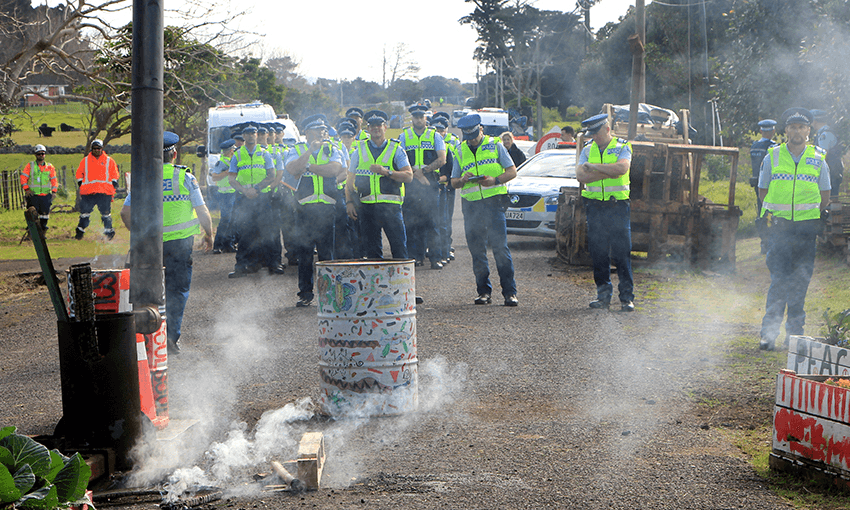Today marks one year since police evicted mana whenua and members of the Protect Ihumātao campaign from land at Ihumātao, South Auckland. Justin Latif looks back at the standoff, the eviction, and what’s happened since.
Has it really been a year?!
Yes it really has. On July 23 2019, police descended on Ihumātao in South Auckland to begin evicting people who had been living on the whenua since 2016. To mark the anniversary, supporters are gathering at Ihumātao at 8.20am, the approximate time police began their eviction, for karakia to reflect on the events of the last year.
So why were police evicting people anyway?
In 2014 the government and Auckland Council designated this section of land a Special Housing Area, following which Fletcher Building bought the land for $19m with plans to build a 480-house development. A group of cousins who live in, and whakapapa to the area became aware of the plan and formed Save Our Unique Landscapes (SOUL) now called Protect Ihumātao, a group that’s now spent more than five years campaigning against the development.
The SHA designation and development plans were a continuation of a number of injustices Ihumātao had faced over decades, from the original land confiscation in 1863 through to the desecration of ancestral maunga for quarrying, the pollution of local awa and moana by the nearby wastewater treatment plant, and the encroachment of industry surrounding the Auckland International Airport.
The land intended for development is right on the edge of the Ōtuataua Stonefields Historic Reserve, which was recently given the highest heritage status by New Zealand Heritage. The area, which is treasured by both iwi and Pākehā alike due to its deep cultural and archaeological significance, was the first market garden location in New Zealand, and parts are considered wāhi tapu as they contain ancestral remains. Ihumātao was also a home to the first two Kings of the Kingitanga movement.
In July of 2019 the protectors at Ihumātao were issued with trespass notices and ordered to vacate the land, sadly mirroring the actions of Governor Grey who evicted the local iwi in 1863 and confiscated their land. This latest eviction sparked a huge police presence, leading to an even bigger turnout of supporters of the Protect Ihumātao campaign, and the issue became national and international headline news.
What’s happened since July last year?
A major development in resolving the standoff between those occupying the land and Fletcher Building occurred on August 3, when the Māori king, Kiingi Tūheitia, visited the site and raised his Kiingitanga flag as a symbolic act to show his commitment to supporting the whānau in finding a resolution.
Following his visit, the Kiingitanga facilitated discussions between the Crown, local iwi representatives – including mana whenua of the Protect Ihumātao campaign who also represent the views of whānau from the Ihumātao papakāinga and the local Makaurau Marae – Auckland Council and Fletcher Building.
I heard that a deal was about to be announced?
On January 22, 2020, Kiingi Tūheitia returned to the South Auckland site to lower his flag after six months of ongoing discussions, leading to speculation an announcement was imminent.
Kiingitanga spokesperson Rahui Papa recently told Radio Waatea there were hopes for a deal to be announced before Waitangi Day, but the decision was currently still sitting with the government.
“That house in Wellington is a round house for a reason because they go around and around and around. I’m not sure where the hold up is. Kiingitanga and mana whenua are poised and ready to go to start some discussions in the hope there is some swift resolution,” he told the radio station.
In June there were reports of a deal involving the government buying the land using the Housing Act. However the prime minister quashed these rumours and finance minister Grant Robertson said he was hoping for a resolution before the election.
“We’re still finalising the arrangements, and there’s obviously a number of parties involved. And, for us, it’s been really important through this process to build trust and to make sure that everybody is on the same page, that takes time. It also means we keep the talks confidential.”
So where does that leave the campaign for Ihumātao?
Qiane Matata-Sipu, a spokesperson for Protect Ihumātao, says the group is pleased with the progress that has been made over the five-year campaign.
“Every day there isn’t a housing development on that whenua, it’s a win,” she says. “This last year is only one part of a very long campaign that has seen so many amazing people contribute to where we are today.
“In the last 12 months, mana whenua reached a consensus, through Kiingitanga facilitation, agreeing for the development to be stopped and for the whenua to be returned.”
And Matata-Sipu says that despite the delays in announcing a resolution, the land is already being utilised in many beneficial ways.
“The whānau of Ihumātao are already living out some of the aspirations for the whenua, planting natives, growing kai and exercising our mana motuhake while helping our people and our local communities thrive through the process.”

